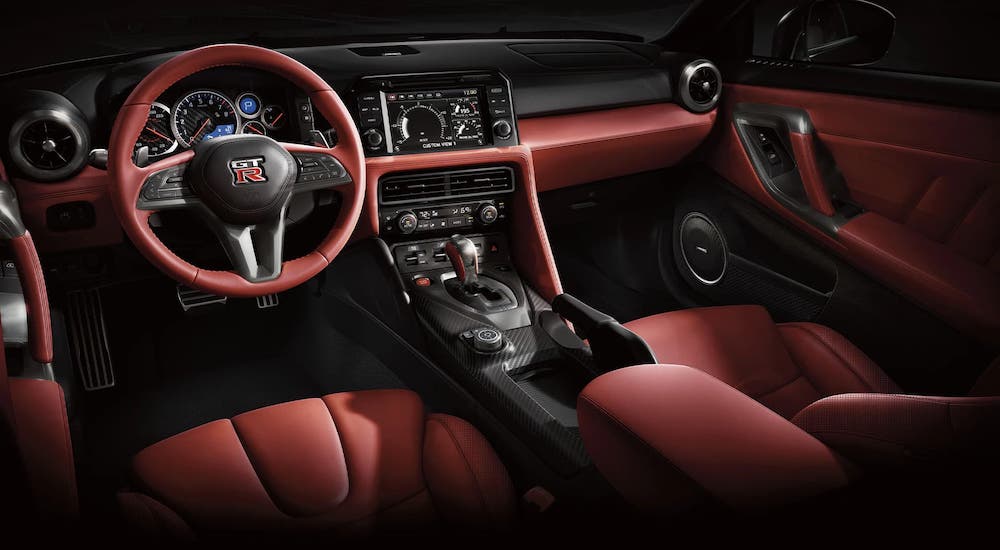Calling a car “beautiful” isn’t unusual. Plenty of cars are styled with a certain aesthetic in mind, and for dedicated gearheads, a well-engineered machine is truly a breathtaking spectacle to behold. From their distinct appearance to the glorious symphony of a revving engine, car manufacturers combine art and engineering to provide drivers with a captivating driving experience. One prime example of beauty synchronizing with power in automotive form can be found at your local Nissan dealer: the 2024 Nissan GT-R.
Many drivers recognize the Nissan GT-R without appreciating the actual craftsmanship and design that go into creating one of these high-performance sports cars. The GT-R went through many iterations before finally appearing on American soil in 2008. In fact, some experts feel that the GT-R has outstayed its welcome on the sportscar scene. However, innovation and dedication from the Nissan engineers, performance drivers, and artists remind drivers around the world that age is nothing but a number with the 2024 Nissan GT-R.
Take a look at how the experts at Nissan have managed to keep this 16-year-old model not only relevant but revolutionary.
The Nissan GT-R: A Brief Recap
Like many cars that were conceived overseas, the GT-R’s origin story involves lots of twists and turns. It starts with what Nissan describes as a “rather modest four-door luxury car,” the Skyline, perhaps one of the boxiest and most pedestrian sedans of its time.
Looking at the regal and almost subdued lines of the inaugural 1957 Skyline, it’s hard to find the family resemblance. However, the Skyline was initially produced by the Prince Motor Company of Japan. In 1966, Prince and Nissan merged, thus shaking up both company’s product lines. After the merger, the Skyline name remained, but the car itself was redesigned as a performance-oriented sports car known as the Skyline GT-R.
From that point in history, the path of the GT-R becomes more predictable. The performance side of the GT-R became its most attractive quality—not that it was lacking in that area. The 1989 R32 Skyline GT-R has been identified as the moment when the GT-R truly came into its own as an all-wheel drive performance vehicle. Only available to drivers in Japan at the time, a track-ified version of the R32 Skyline GT-R entered the 1989 Japanese Touring Car Championship and won 29 races in a row over the following four seasons.
While it would still be nearly 20 years before the Nissan GT-R officially came to America, the sportscar with a reputation to rival European supercars was well known among performance enthusiasts. Eventually, the equally stunning and graceful 1999 Nissan Skyline R34 GT-R was even cast in a significant role in the Fast and the Furious franchise. Still, it was impossible to get one. In fact, it just became legal to import a Nissan R34 Skyline as of May 2023 under the Imported Vehicle Safety Compliance Act of 1988, which states that collectible vehicles of 25 years of age or above may be admitted to the US.
But all of that is behind us. We have since enjoyed 16 years of the GT-R gracing the streets of Japan and beyond.

The Beauty of Speed
So here’s the thing: Not only is the GT-R really fast, but Nissan wants everyone to know exactly how the GT-R got its giddy-up. The formula is equal parts art and science.
Let’s start with the basics. According to Nissan, all you need to create your own 2024 GT-R is a 3.8L twin-turbocharged V6 engine with IHI integrated turbos, ATTESA E-TS all-wheel drive, a braking system designed in collaboration between Nissan and Brembo, and a Midship platform. Put all that together, and you get 565 hp and 467 lb-ft of torque. Or, if you’re looking for NISMO-level power, make that 600 hp and 481 lb-ft of torque.
Easy, right? We all have that lying around in our garage, right?
Interestingly enough, the GT-R’s engine is built by hand, just like whatever machinery you might combine in your garage. The master craftsmen who assemble each GT-R engine are known as Takumi. According to Nissan, there are only five Takumi in the world. If you take a peek at a GT-R engine, you’ll see a plaque with the signature of the Takumi who assembled that particular engine.
The Art and the Artist
Having each engine assembled by a limited number of expert hands may seem a bit extraordinary, especially for those who understand how long this car takes to build and how much skill is involved in the process. Still, there are very valid reasons for the Takumi to handle this specific role.
The engine of the 2024 Nissan GT-R is immaculately designed to nano-level specifications. Nissan eagerly shares the process through which each piece and part is carefully calibrated to work uniformly for the highest level of performance. Each side of the engine has its own turbocharger, intercooler, and catalyst. Plasma-sprayed bores are the not-so-secret ingredient that keeps the cylinders chugging along with less friction and weight.
Along the same lines, the Premium Midship Platform allows engineers to carefully balance the engine where it needs to be to allow better handling at the front of the vehicle. Nissan decided to take the perfection of its creation further by placing the transmission away from the engine. With the transmission mounted with the transfer case, an independent rear transaxle is unleashed, thus improving traction, braking, and cooling capability. Nissan feels this process is better handled on a car-by-car basis, with limited assembly crew members who can test each vehicle to ensure all specs are custom-calibrated to each individual car.
Also built by hand is the titanium exhaust system. Every 2024 GT-R receives its own custom-designed exhaust based on the dynamics and performance of that particular vehicle. Throughout production, every GT-R is shaken, jiggled, tested, and eventually driven at the Tochigi test track. Only the vehicles that pass these tests are released to the outside world and a waiting driving public.
Blurring the Lines Between Art and Engineering
There are many things that distinguish a 2024 Nissan GT-R from other vehicles. There’s the performance, of course. Anyone would surely be captivated by a roaring 600 hp. But even more fascinating is the process through which the GT-R is conceived, designed, and assembled. Piece by piece, the GT-R is constructed, tested, calibrated, and reviewed to ensure that each of the gears, like instruments in an orchestra, are in perfect harmony. With an MSRP of $120,990, the GT-R is not a car to be purchased on a whim, which is appropriate because its balance of style and performance deserves a great deal of thought and consideration.
Is a Takumi an artist, a conductor, or a craftsman? Perhaps the answer is that a Takumi embodies all of these roles, just as the GT-R itself is a culmination of passion, creativity, and innovation.
The GT-R may be getting up in years as far as automobile production goes, but there’s nothing old or outdated about this sportscar. As a matter of sport, its performance is on par with the great names in Europe, Japan, and the USA. As a matter of art, the Nissan GT-R is practically incomparable.





